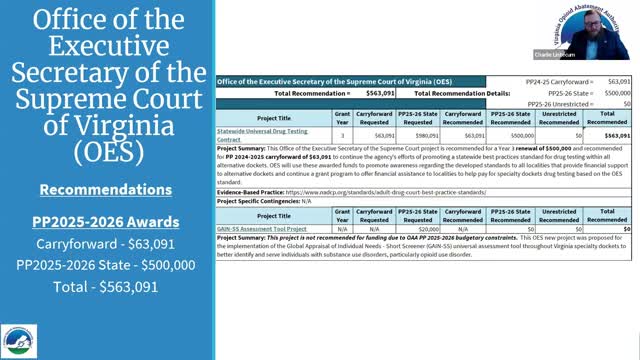Radford University and University of Mary Washington Expand Collegiate Recovery Programs
August 02, 2025 | Opioid Abatement Authority, Boards and Commissions, Executive, Virginia
This article was created by AI summarizing key points discussed. AI makes mistakes, so for full details and context, please refer to the video of the full meeting. Please report any errors so we can fix them. Report an error »

The Virginia Opioid Abatement Authority convened on August 1, 2025, to discuss critical initiatives aimed at addressing substance use disorders, particularly opioid addiction, across the state. The meeting highlighted ongoing projects and new proposals from various universities, emphasizing the collaborative efforts to enhance recovery support and education.
One of the key discussions centered around Radford University's Project Hope, now in its third year. This collegiate recovery program has established a supportive living environment for individuals in recovery, featuring a four-bedroom suite designed to foster community and provide essential resources. The program has actively engaged with local organizations, including Greek life, to promote awareness and distribute naloxone, a life-saving medication that reverses opioid overdoses.
The University of Mary Washington also presented its Eagles in Recovery program, which aims to support students affected by substance use disorders. The proposed funding will facilitate the hiring of a health and well-being intern tasked with developing outreach strategies to promote wellness and educate the campus community about available resources.
Additionally, the University of Virginia reported on the renewal of two significant projects. The COSMOS Project focuses on digital contingency management for substance use disorder treatment, while the SMART clinic operates as a street medicine initiative, providing opioid treatment in a multi-resource day shelter. This approach allows healthcare providers to meet individuals in need where they are, addressing both their medical and social support requirements.
The meeting underscored the importance of these initiatives in combating the opioid crisis in Virginia. By fostering partnerships between educational institutions and community organizations, the state aims to create a more informed and supportive environment for individuals in recovery. As these projects progress, the Virginia Opioid Abatement Authority will continue to monitor their impact and effectiveness, ensuring that resources are allocated efficiently to meet the needs of those affected by substance use disorders.
One of the key discussions centered around Radford University's Project Hope, now in its third year. This collegiate recovery program has established a supportive living environment for individuals in recovery, featuring a four-bedroom suite designed to foster community and provide essential resources. The program has actively engaged with local organizations, including Greek life, to promote awareness and distribute naloxone, a life-saving medication that reverses opioid overdoses.
The University of Mary Washington also presented its Eagles in Recovery program, which aims to support students affected by substance use disorders. The proposed funding will facilitate the hiring of a health and well-being intern tasked with developing outreach strategies to promote wellness and educate the campus community about available resources.
Additionally, the University of Virginia reported on the renewal of two significant projects. The COSMOS Project focuses on digital contingency management for substance use disorder treatment, while the SMART clinic operates as a street medicine initiative, providing opioid treatment in a multi-resource day shelter. This approach allows healthcare providers to meet individuals in need where they are, addressing both their medical and social support requirements.
The meeting underscored the importance of these initiatives in combating the opioid crisis in Virginia. By fostering partnerships between educational institutions and community organizations, the state aims to create a more informed and supportive environment for individuals in recovery. As these projects progress, the Virginia Opioid Abatement Authority will continue to monitor their impact and effectiveness, ensuring that resources are allocated efficiently to meet the needs of those affected by substance use disorders.
View full meeting
This article is based on a recent meeting—watch the full video and explore the complete transcript for deeper insights into the discussion.
View full meeting
